Why Do Women Wear Hats in the Markets of Peru?
![]()
![]()
Chapter 1: Introduction to Women in Hats
Chapter 2: Men in Hats
Chapter 3: Conclusion of Why Women Wear Hats in the Market Place
Introductory Note: In June, 2002, Fran and I took a trip with Overseas Adventure Travel (OAT) to Peru, The Galapagos, and Ecuador. As you know, when I travel I like to take "Character" photos. Sometimes I get a winner; sometimes I get a loser; but I always get a story. When in Peru and Ecuador I tried hard and got some good shots. The following are copies of e-mail messages I sent out upon my return from this trip.
| I worked very hard at getting some great shots of hats in Peru and Equador and have worked long hours at trying to solve the
age old question of why do women wear hats. In an effort to share with you my thoughts I have been sending some pretty good pictures.
But one of you, who shall go un-named but you know who you are because you are named after a famous Italian tenor, had the unmitigated
brazen gall to say: "Okay, I'm getting it now. This was just an excuse to look at the women, and not have Fran get upset." So in order to prove this is not true I want to take a side journey and show you some of the hats the men wear as well. |
 |
I caught this native in a field tending to his llama outside the Hacienda Cusin, built in 1602. (More about that later) He just happened to look up as the photograph was taken. |
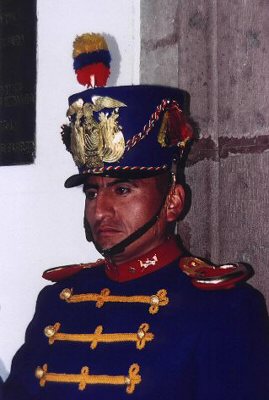 |
But as you can see, the hats worn by some men are more utilitarian and sometimes not as colorful as the women. It is not at all like the kind you see worn by the guards standing outside the palace in Quito, Ecuador.I have been challenged and to show that I was fair in my search for the truth I will provide you more later. |
| When we were in Equador we visited the Saturday market in Otavalo and were advised by our tour director, George, that we will
notice the dress worn by the men and the women. You have previously seen a picture of a woman with the scarf on top of her head
serving as a hat and the gold beads around her neck. The men, on the other hand, traditionally wear a white shirt, white trousers,
a vest - generally white - sandals and a white felt hat. Note the woman on the left wearing the traditional black and white skirt, embroidered blouse and black and her hat made up of a black and white folded scarf . |
 |
| One of the treats of traveling in Peru and Ecuador was going to the local outdoor market. You can buy anything from beans, corn and potatoes to clothing and household goods. I frequently saw men walking through the market, obviously wearing the required hat and tall boots, with a rope around their shoulders. I thought maybe they had a horse somewhere. | 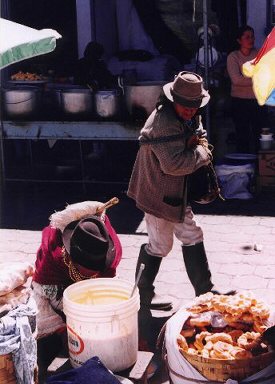 |
I finally asked our tour director why these men were carrying a rope. He said, "They are carriers. You can hire them to carry your purchase from the market." It was surprising to see how much people carried on their backs. The women would wrap their baby in a shawl and carry it on their back. They would wrap their fruit and vegetables in a shawl and carry it on their back. You didn't see many people carrying their market purchases in a plastic bag. |
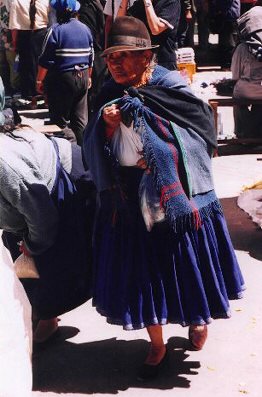 Notice her fine hat? |
But naturally, if you made a big purchase, such as a new woven reed mat for the dirt floor of your home you would hire a "carrier" to take it home for you. See, the rope comes in handy. | 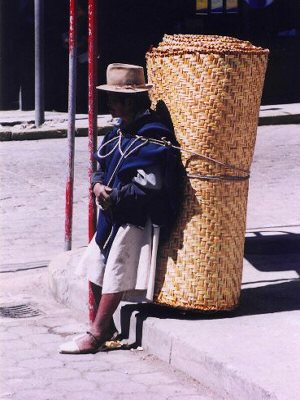 |
| Of course not every man has a flamboyant military hat to wear in Peru. The government seems to have a need to put hats on people which tend to intimidate - look at the neat new Berea worn by the U.S. Army. LOL Anyway, if you are just a working stiff you choose a hat which is appropriate for the job to be done. Thus, if you happen to be in the Cuzco airport playing in a quartet to entertain foreign tourists you would want to wear the clothing of your native tribe which would include a typical hat made of a local product. | 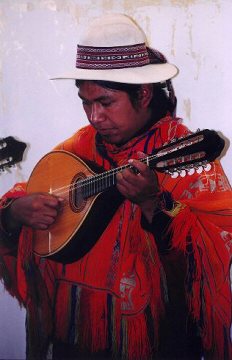 |
In this case the hat is a "Panama" made of straw. It is impervious to the rain and can be shaped easily. It seems like one size fits all. |
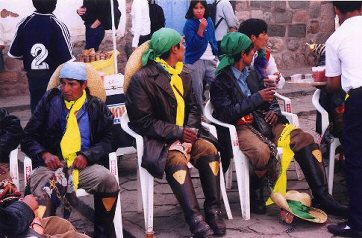 |
If, on the other hand, if you are lucky enough to be chosen to carry the statue of Saint Blas back to your parish church following the blessing on Corpus Christie (go back to my earlier message and see previous photo) you would wear something that had no brim which would get in the way; but you would wear a head covering...... As you can imagine, these men are wearing their traditional clothing for this area. |
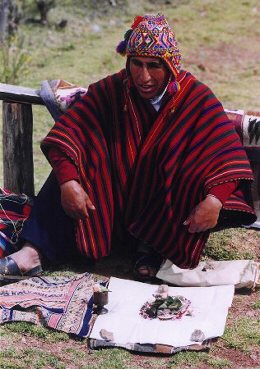 |
The Peruvian hats you may be more familiar with are worn by the native men in the countryside. This is a photograph of the local medicine man from the mountains outside of Cuzco. One day we were treated to a "cleansing" by him. This is a traditional folk method of removing all the evils and bad spirits in you. After first entreating the gods of the mother earth and mountains he spread a cloth in front of him and, blessing each item one by one, he placed small samples of the bounty of the forests and fields on them. The items were the wrapped in a cloth and each of us was invited to be "cleansed". We were wiped from head to toe with the wrapped cloth to be cleansed. |
| Finally, invoking the name of the tallest mountain in the area we lived we were told to blow on the cloth which told the spirits of that mountain we were clean. For some people this was easy - if you lived in Seattle, Washington, you could name Mount Rainer (14,410 feet) ; or if you were in Albuquerque you could name the Sandia Mountains (10,684 feet) - but for us in Minnesota we had to think long and hard. I named Lutsin Mountain (maybe 1000 feet) and Fran named Afton Mountain (about 950 feet). I think our mountain gods are just tinkers in comparison to those living in the Andes. Once we were all cleaned the contents of the cloth were burned. Marie, from Milwaukee described it thus: |  |
| He is not at the top of the medicine man hierarchy, however, because he can not perform medical treatments. Using a medicine man to treat illnesses and bodily dysfunctions is a tradition that goes back a long time. We were told by our travel director, Maricella, that these treatments really work. She described from first hand knowledge a woman with a large abscess on her jaw which would not heal by traditionally accepted medical methods. The medicine man was called in and the abscess was covered with herbs and salves made from the bounty of the earth. The gods were invoked and the abscess drained and slowly disappeared without leaving a scar. Who are we to challenge the work of the gods? | 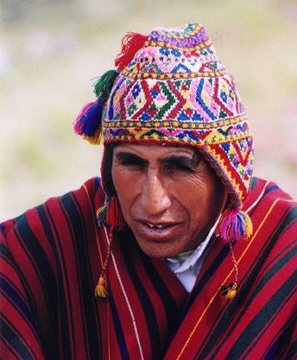
|
The hat worn by the medicine man is a traditional one worn by the native men in the countryside. You can see it provides color and is quite utilitarian. It keeps the head warm during the cold mountain days and nights. The ear flaps provide warmth to the side of the head when it is cold and can be tied up when it is warm. If the sun is shining in your face the ear flaps can be pulled around to shade part of the face. |
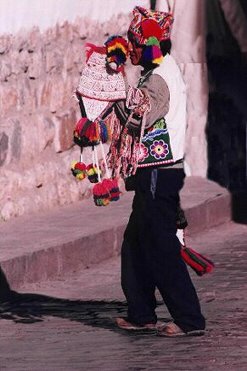 |
Obviously, when we were in Cuzco we had the opportunity, which I now regret not taking, of purchasing one of these most colorful
and utilitarian garments of clothing. An opportunity lost. One rule of traveling: When you see something that you think you should
buy, but then talk yourself out of it, you have made a mistake and you will regret it when you get home.
Anyway, we can all use some more "stuff". |
| What have you learned this far? What can you tell me about this native woman walking past an ancient Inca ruin in Cuzco? Look at the colorful clothing, everyone wears sandals on their feet, embroidered jacket and blouse, scarf around her shoulders to carry things, and a wonderful colorful hat. Compare her to the drab nondescript colorless hats and clothing of the tourists in the background. |  |
The building, Nazarenas Monastery) was originally built by the Inca. Look at the large stones making up the front. It was then turned into a church and monastery by the Spaniards. Unfortunately, as so often happens in these poor countries which are blessed with magnificent ruins but no money to maintain them, the property was bought by a hotel and it has now been changed into a five star Hilton (if my memory serves me correctly, and, it is my story). Part of the condition of the sale was that the hotel maintain the magnificent church on the grounds. It is too bad but most of the churches do not allow photographs inside and thus I can not share with you much of the interior beauty. One interesting tidbit is that when the Spaniards arrived and changed many of the Inca pagan buildings into churches they covered the ancient stone walls with a facade of brick. Cuzco is in an earthquake zone and as the earthquakes occurred over the years the Spanish facades fell down but the Inca stonework remained. I guess this tells us something about just how "underdeveloped" the Inca were. |
| Naturally, like everywhere else in the world, adults learn their dress habits as small children. Children watch their parents and want to dress like them as they see their father's go off to work in the field. High in the mountains of the Andes llamas are raised both for their wool and for their meat. In fact, one day we had Alpaca for lunch. Baby Alpaca wool is treasured for its warmth and softness. The cost of a sweater in Peru is a 10th of what you would pay in the United States. Alpaca sweaters, for men and women are found everywhere and naturally Fran brought one home. The wool is shorn from the Alpaca, and llamas, just as wool is taken from sheep. It is my understanding that the baby Alpaca wool is finest because it comes from the chest of the animal. Naturally the care provided by your master makes it a loving affair. |  |
This young farm boy, wearing a traditional country Peruvian hat and red cape was leading his llama to pasture. I suspect that the blue jeans and tennis shoes are from another era. |
| You have probably noted that many of the people in our pictures were wearing coats, or capes, or jackets, or sweaters, whereas we were just in long sleeve shirts. We were warned that it was "cold" in Peru - of course it was winter down there for them and we were at 10,500 feet in Cuzco. We were told that the Inca have more red blood cells which provides them with more oxygen which allows them to work in the higher altitudes. It is odd, however, that they haven't developed the "thick" blood we have in Minnesota which also keeps them warm. In Peru they have no heat in their homes, they just put on more clothing. Thus, in addition to looking at the hats the people are wearing, the theme of my story, you might also pay attention to how warmly they are dressed. | 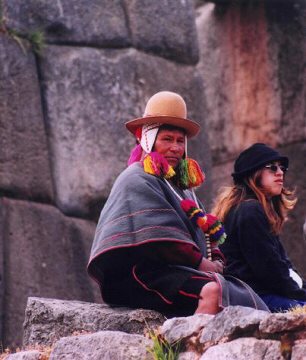 |
This native at the ruins of Sacsayhuaman (pronounced "socksie human"), above Cuzco, is wearing two hats and a heavy cape for warmth. |
| Just thought you might enjoy this photo of two small boys and their baby llama outside a shop at Sacsayhuaman near Cuzco. Notice how the boy on the right is squinting his eyes in the sun but the boy on the right has his eyes open. He can do that because he has his hat (cap) twisted around to the front of his face to shield his eyes. Anyway, this was just another excuse to show you one of my better pictures. | 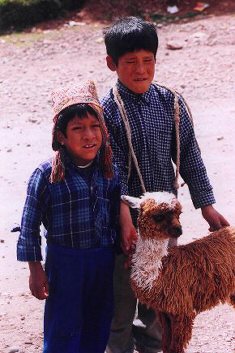 |
Go To Chapter 3: Conclusion of Why Women Wear Hats in the Market Place.
